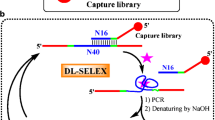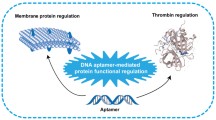Summary
Aptamers are single-stranded functional nucleic acids that possess cognate ligand recognition capability. These functional nucleic acids have been used for biosensing of a variety of ligands. Aptamers are isolated by “in vitro selection” or SELEX from random-sequence nucleic acid pools. For example, DNA aptamers that recognize a protein can be generated by applying a DNA library to an affinity column containing the protein target and retrieving the bound sequences after wash. These sequences are amplified and used for a new round of binding and amplification. The identity of enriched sequences are subsequently revealed by cloning and sequencing. The binding of individual aptamers to the protein can be confirmed by techniques such as gel mobility shift. This chapter will provide a detailed protocol for isolating protein-binding DNA aptamers.
Access this chapter
Tax calculation will be finalised at checkout
Purchases are for personal use only
Similar content being viewed by others
References
Southern, E. M. (1975). “Detection of specific sequences among DNA fragments separated by gel electrophoresis.”J Mol Biol98, 503–517
Schena, M. and D. Shalon, et al. (1995). “Quantitative monitoring of gene expression patterns with a complementary DNA micro-array.”Science270, 467–470
Bunka, D. H. and P. G. Stockley (2006). “Aptamers come of age - at last.”Nat Rev Microbiol4, 588–596
Tuerk, C. and L. Gold (1990). “Systematic evolution of ligands by exponential enrichment: RNA ligands to bacteriophage T4 DNA polymerase.”Science249, 505–510
Ellington, A. D. and J. W. Szostak (1990). “In vitro selection of RNA molecules that bind specific ligands.”Nature346, 818–822
Nutiu, R. and Y. Li (2005). “Aptamers with fluorescence-signaling properties.”Methods37, 16–25
Nutiu, R. and Y. Li (2003). “Structure-switching signaling aptamers.”J Am Chem Soc125, 4771–4778
Nutiu, R. and Y. Li (2004). “Structure-switching signaling aptamers: transducing molecular recognition into fluorescence signaling.”Chemistry10, 1868–1876
Navani, N. K. and Y. Li (2006). “Nucleic acid aptamers and enzymes as sensors.”Curr Opin Chem Biol10, 272–281
Zuker, M. (2003). “Mfold web server for nucleic acid folding and hybridization prediction.”Nucleic Acids Res31, 3406–3415
Dobbelstein, M. and T. Shenk (1995). “In vitro selection of RNA ligands for the ribosomal L22 protein associated with Epstein-Barr virus-expressed RNA by using randomized and cDNA-derived RNA libraries.”J Virol69, 8027–8034
Berezovski, M. and A. Drabovich, et al. (2005). “Nonequilibrium capillary electro-phoresis of equilibrium mixtures: a universal tool for development of aptamers.”J Am Chem Soc127, 3165–3171
Smith, D. and G. P. Kirschenheuter, et al. (1995). “In vitro selection of RNA-based irreversible inhibitors of human neutrophil elastase.”Chem Biol2, 741–750
Zhang, F. and D. Anderson (1998). “In vitro selection of bacteriophage phi29 prohead RNA aptamers for prohead binding.”J Biol Chem273, 2947–2953
Blank, M. and T. Weinschenk, et al. (2001). “Systematic evolution of a DNA aptamer binding to rat brain tumor microvessels. selective targeting of endothelial regulatory protein pigpen.”J Biol Chem276, 16464–16468
Cox, J. C. and A. D. Ellington (2001). “Automated selection of anti-protein aptam-ers.”Bioorg Med Chem9, 2525–2531
Cadwell, R. C. and G. F. Joyce (1994). “Mutagenic PCR.”PCR Method Appl3, S130–S140
Acknowledgments
The aptamer research in the Li lab is funded by Genome Canada through Ontario Genomics Institute, the Canadian Institutes of Health Research, and Natural Sciences and Engineering Research Council of Canada. YL holds a Canada Research Chair.
Author information
Authors and Affiliations
Editor information
Editors and Affiliations
Rights and permissions
Copyright information
© 2009 Humana Press, a part of Springer Science+Business Media, LLC, a part of Springer Science+Business Media, LLC
About this protocol
Cite this protocol
Navani, N.K., Mok, W.K., Yingfu, L. (2009). In Vitro Selection of Protein-Binding DNA Aptamers as Ligands for Biosensing Applications. In: Rasooly, A., Herold, K.E. (eds) Biosensors and Biodetection. Methods in Molecular Biology™, vol 504. Humana Press. https://doi.org/10.1007/978-1-60327-569-9_22
Download citation
DOI: https://doi.org/10.1007/978-1-60327-569-9_22
Publisher Name: Humana Press
Print ISBN: 978-1-60327-568-2
Online ISBN: 978-1-60327-569-9
eBook Packages: Springer Protocols




